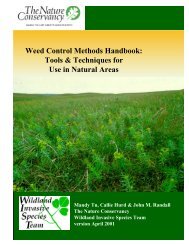spotted knapweed population explosion - Okanogan County
spotted knapweed population explosion - Okanogan County
spotted knapweed population explosion - Okanogan County
You also want an ePaper? Increase the reach of your titles
YUMPU automatically turns print PDFs into web optimized ePapers that Google loves.
SPOTTED KNAPWEED POPULATION<br />
Last summer Mr. Al Oughtamoney, with plans to build a home, hired the ACE road building<br />
company to build a road to his property. The road crosses one mile of gently sloping native<br />
grassland in Natrona <strong>County</strong>, Wyoming. By the time ACE bulldozed the roadbed, Al ran out of<br />
money and has been unable to finish the road or build the house. The road was closed and<br />
abandoned. Use the following information to answer the questions about the spread of <strong>spotted</strong><br />
<strong>knapweed</strong>.<br />
1. Seed production: Knapweed plants produce an average of 1,000 seeds per plant.<br />
2. Seed germination rate: 4 percent of the seeds in the seedbank germinate (sprout) each year,<br />
leaving 96 percent for next year's seedbank.<br />
3. Seedling survival: 25 percent of the seedlings that germinate each year survive to become mature<br />
plants. (One percent of the seeds in the seedbank germinate and survive each year.)<br />
4. Knapweed plants on this site live five years.<br />
5. Knapweed seeds remain viable in the soil for eight years.<br />
6. Conditions on this site allow <strong>knapweed</strong> to germinate, form a rosette, bolt, and<br />
produce seed in one year.<br />
7. This site will support three mature <strong>knapweed</strong> plants per square foot.<br />
8. There are 43,560 square feet in 1 acre.<br />
9. There are 5,280 feet in 1 mile.<br />
Assignment: Although the road builders were very careful not to carry in any <strong>knapweed</strong> seeds,<br />
soon after they quit the project, Cody, a 7th grader at the local school, rode his mountain bike past<br />
the locked gate and up the new road to see where it went. On the way he took a short cut through a<br />
field, and many <strong>knapweed</strong> seedheads got caught on his bicycle. As Cody bounced up the road, 100<br />
<strong>knapweed</strong> seeds fell from his bike to the freshly disturbed roadbed.<br />
Use the above information to calculate and graph:<br />
1. The number of plants at the beginning of each year for five years from the year after Cody rode<br />
his bike up the road.<br />
2. The number of seeds in the seedbank at the end of each year for five years, from the year after<br />
Cody rode his bike up the road.<br />
3. If the roadway is 40 feet wide, how many <strong>knapweed</strong> plants will grow there and about how long<br />
will it take before the entire new road is covered with mature <strong>knapweed</strong> plants?<br />
Extra: If this rate of spread continues, how many acres will be covered with <strong>knapweed</strong> after 10<br />
years?
KNAPWEED POPULATION EXPLOSION<br />
ANSWER SHEET<br />
1 and 2..<br />
1st year: One plant survives from the seeds Cody dropped. 96 seeds carry over and add to the 1,000<br />
from the one plant.<br />
2nd year: 11 plants survive from seed bank. Add to first year for 12 plants. These produce 12,000<br />
new seeds plus 96 percent of last year's seedbank for 13,052 seeds.<br />
Continue for at least 5 years taking 1 percent of the previous year's seedbank and adding to the<br />
previous year's plants for the new number of plants. Multiply plant times 1,000 and add to 96<br />
percent of the previous year's seedbank for the new seedbank. Don't forget that plants only live five<br />
years! You must subtract year 1 from year 6, year 2 from year 7, etc. Also, seeds are viable for only<br />
8 years so you must subtract 100 from year 8' s seedbank, year l' s seedbank from year 9' s, etc.<br />
Here are the numbers over 10 years. The questions require graphs for only five years.<br />
Year Plants Seeds<br />
0 0 100<br />
1 1 1,096<br />
2 12 13,052<br />
3 143 155,530<br />
4 1698 1,847,309<br />
5 20,171 21,944,417<br />
6 239,614 260,680,640<br />
7 2,846,408 3,096,661,414<br />
8 33,812,879 36,785,673,858<br />
9 401,667,920 436,982,165,807<br />
10 4,771,469,407 5,190,972,273,123
Answer Sheet (continued)<br />
3. 5,280 feet/mile x 40 feet wide = 211,200 feet 2<br />
211,200 feet 2 x 3 plants/ft 2 = 633,600 plants. After the sixth year.<br />
Extra: 4,771,469,407 plants after 10 yrs. / 3 plants per ft. 2 = 1,590,489,802 ft.²<br />
1,590,489,802 ft.² / 43,560 ft.² per acre = 36,513 acres after 10 years !<br />
(640 acres in a square mile, so that’s 57 miles² !!!!!!) How big is 57 miles²? It is about twice as<br />
big as the City of Casper!!!!!<br />
Food for Thought?<br />
How many acres of native plants would this ten year <strong>knapweed</strong> infestation displace?<br />
(36,513 acres – 211,200 ft² (or ~ 5 acres for the roadway) = 36,508 acres of native plants)<br />
What animal species might rely (directly or indirectly) on those native plant species?<br />
(elk, deer, antelope, rodents, rabbits, mice, badgers, coyotes, birds, snakes, insects, etc.<br />
How would it affect those animal species?<br />
(no food for the herbivores, i.e. no food for the carnivores….animals would “move out”….is<br />
adjacent habitat “full”?....what would happen to displaced animals?)<br />
How can we help prevent this “biological wildfire” from occurring?<br />
(education, prevention, control of existing infestations, etc.)<br />
HELP KEEP WYOMING NATIVE !!!
















